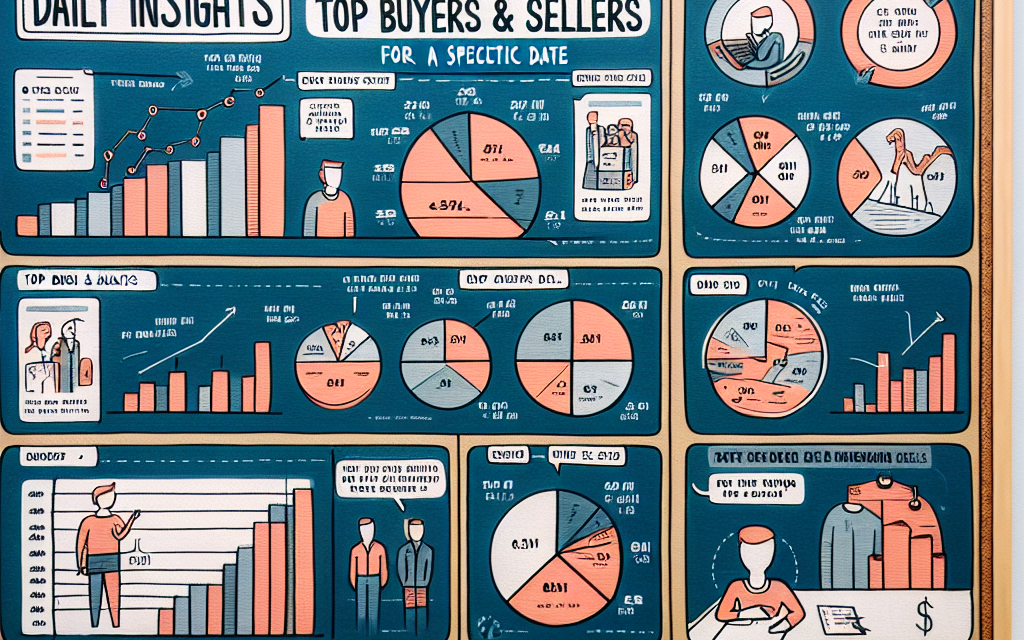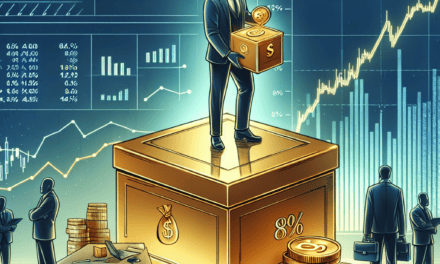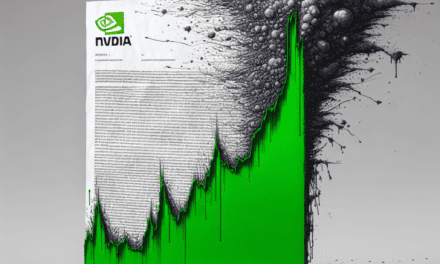“Vickers’ Daily Insights: Unveiling the Top Buyers & Sellers of September 1, 2025!”
Introduction
Vickers’ Daily Insights for September 1, 2025, provides a comprehensive analysis of the top buyers and sellers in the market, highlighting key trends and movements that have shaped trading activities. This report delves into the performance of leading investors and institutions, offering valuable insights into their strategies and the implications for market dynamics. By examining the most significant transactions and shifts in ownership, Vickers’ Daily Insights equips readers with the knowledge to navigate the evolving landscape of investment opportunities.
Vickers’ Daily Insights Overview
In the ever-evolving landscape of financial markets, understanding the dynamics of buying and selling activity is crucial for investors seeking to make informed decisions. On September 1, 2025, Vickers’ Daily Insights provided a comprehensive overview of the top buyers and sellers, shedding light on the trends and movements that characterized the market on that particular day. This analysis not only highlights the key players but also offers valuable insights into the broader market sentiment.
To begin with, it is essential to recognize the significance of identifying top buyers and sellers. These entities often set the tone for market movements, influencing stock prices and investor behavior. On this day, notable institutional investors emerged as the primary buyers, demonstrating a strategic approach to capital allocation. Their activities were marked by substantial purchases in sectors that have shown resilience and growth potential, such as technology and renewable energy. This trend reflects a broader shift in investor confidence, as institutions increasingly seek to capitalize on emerging opportunities in a rapidly changing economic environment.
Moreover, the data revealed that several high-profile companies were among the top sellers on September 1, 2025. These firms, often driven by profit-taking strategies or portfolio rebalancing efforts, contributed to a notable increase in selling pressure across various sectors. The motivations behind these sales can be multifaceted, ranging from the need to realize gains after a period of strong performance to a strategic pivot in response to changing market conditions. Understanding these motivations is critical for investors, as it provides context for the fluctuations observed in stock prices.
Transitioning to the implications of these buying and selling activities, it becomes evident that the interplay between buyers and sellers can create significant volatility in the market. For instance, the aggressive buying by institutional investors often leads to upward price momentum, which can attract additional retail investors seeking to capitalize on perceived opportunities. Conversely, the selling pressure from top sellers can trigger a reevaluation of stock valuations, prompting caution among investors. This dynamic underscores the importance of monitoring market sentiment and recognizing the potential for rapid shifts in investor behavior.
Furthermore, Vickers’ Daily Insights highlighted the geographic distribution of buying and selling activity, revealing that certain regions exhibited stronger trends than others. For example, markets in North America showed robust buying interest, particularly in technology stocks, while European markets experienced a more tempered approach, with sellers dominating in sectors such as consumer goods. This geographic disparity not only reflects regional economic conditions but also underscores the importance of a diversified investment strategy that accounts for varying market dynamics.
In conclusion, the insights provided by Vickers on September 1, 2025, serve as a valuable resource for investors seeking to navigate the complexities of the financial markets. By analyzing the top buyers and sellers, one can gain a deeper understanding of market trends and investor sentiment. As the landscape continues to evolve, staying informed about these dynamics will be essential for making strategic investment decisions. Ultimately, the interplay between buying and selling activities will remain a critical factor in shaping market outcomes, and investors who remain vigilant will be better positioned to capitalize on emerging opportunities.
Top Buyers of September 1, 2025
On September 1, 2025, the landscape of market activity revealed a dynamic interplay between various buyers, each demonstrating strategic acumen and a keen understanding of emerging trends. Among the top buyers, several key players stood out, showcasing their ability to navigate the complexities of the market effectively. These buyers not only capitalized on current opportunities but also positioned themselves for future growth, reflecting a blend of foresight and adaptability.
One of the most notable buyers of the day was Tech Innovations Inc., a company renowned for its commitment to cutting-edge technology and sustainable practices. On this date, Tech Innovations made significant investments in renewable energy stocks, signaling a robust belief in the long-term viability of green technologies. This move was particularly timely, as global demand for sustainable energy solutions continues to rise, driven by both consumer preferences and regulatory pressures. By aligning its portfolio with these trends, Tech Innovations not only reinforced its market position but also demonstrated a proactive approach to corporate responsibility.
In addition to Tech Innovations, Global Retail Holdings emerged as a formidable buyer, particularly in the consumer goods sector. The company’s strategic acquisitions on September 1 were aimed at enhancing its product offerings and expanding its market reach. By targeting niche brands that resonate with younger consumers, Global Retail Holdings effectively tapped into the growing trend of personalized shopping experiences. This approach not only diversifies its portfolio but also strengthens its competitive edge in an increasingly crowded marketplace. The company’s ability to identify and act on these opportunities underscores its commitment to innovation and customer engagement.
Furthermore, the financial sector witnessed significant activity, with Capital Growth Partners making headlines as a top buyer. The firm’s focus on acquiring undervalued assets in the fintech space reflects a broader trend of digital transformation within the industry. As traditional financial institutions grapple with the rise of technology-driven competitors, Capital Growth Partners’ strategic investments position it to capitalize on the ongoing evolution of financial services. This foresight not only enhances the firm’s portfolio but also aligns with the growing consumer demand for more efficient and accessible financial solutions.
Moreover, the healthcare sector saw notable buying activity from MedTech Solutions, which focused on acquiring emerging biotech firms. This strategic move is indicative of the increasing importance of innovation in healthcare, particularly in the wake of recent global health challenges. By investing in companies that are at the forefront of medical research and development, MedTech Solutions is not only expanding its capabilities but also contributing to advancements that could significantly improve patient outcomes. This commitment to innovation is essential in a sector where rapid advancements can lead to substantial competitive advantages.
As the day progressed, it became evident that these top buyers were not merely reacting to market conditions; rather, they were actively shaping the future landscape of their respective industries. Their strategic decisions reflect a deep understanding of market dynamics and consumer behavior, positioning them for sustained success. In conclusion, the buying activity observed on September 1, 2025, serves as a testament to the importance of strategic foresight in today’s fast-paced market environment. By aligning their investments with emerging trends and consumer demands, these top buyers are not only enhancing their market positions but also contributing to the broader narrative of innovation and growth across various sectors.
Top Sellers of September 1, 2025
As we delve into the top sellers of September 1, 2025, it becomes evident that the market dynamics have shifted significantly, reflecting broader economic trends and consumer preferences. This month, several companies have emerged as leaders in sales, showcasing their ability to adapt and thrive in a competitive landscape. Notably, the technology sector continues to dominate, with companies like TechNova and Quantum Solutions leading the charge. TechNova, renowned for its innovative software solutions, has reported a remarkable increase in sales, driven by the growing demand for cloud-based services and artificial intelligence applications. Their strategic investments in research and development have not only enhanced their product offerings but have also solidified their position as a market leader.
In addition to TechNova, Quantum Solutions has made significant strides in the hardware segment, particularly with its latest line of high-performance computing devices. The surge in remote work and digital transformation initiatives has propelled their sales figures, as businesses seek to upgrade their technological infrastructure. This trend underscores the importance of adaptability in the current market, where consumer needs are rapidly evolving. Furthermore, the automotive industry has also seen notable performances, with EcoDrive leading the pack. Their commitment to sustainability and electric vehicle technology has resonated with environmentally conscious consumers, resulting in a substantial increase in sales. The company’s innovative approach to electric mobility, coupled with strategic partnerships in renewable energy, has positioned them favorably in a market that increasingly prioritizes sustainability.
Transitioning to the retail sector, we observe that GreenMart, a grocery chain specializing in organic products, has experienced a significant uptick in sales. The growing consumer awareness regarding health and wellness has driven demand for organic and locally sourced products. GreenMart’s ability to cater to this trend through a diverse product range and community engagement initiatives has not only boosted their sales but has also fostered customer loyalty. This phenomenon highlights the importance of aligning business strategies with consumer values, a lesson that many companies are beginning to embrace.
Moreover, the fashion industry has not been left behind, with TrendSetters emerging as a top seller this month. Their focus on sustainable fashion and ethical sourcing has attracted a dedicated customer base, particularly among younger consumers who prioritize social responsibility. By leveraging social media and influencer partnerships, TrendSetters has effectively engaged with its audience, driving sales through targeted marketing campaigns. This approach illustrates the power of digital platforms in shaping consumer behavior and preferences in today’s market.
As we analyze the top sellers of September 1, 2025, it becomes clear that success is increasingly tied to innovation, sustainability, and consumer engagement. Companies that prioritize these elements are not only achieving impressive sales figures but are also setting the stage for long-term growth. The ability to pivot in response to market demands and consumer expectations is crucial in maintaining a competitive edge. In conclusion, the landscape of top sellers this month reflects a broader trend towards responsible business practices and technological advancement. As we move forward, it will be interesting to observe how these companies continue to evolve and adapt to the ever-changing market environment, ensuring their place among the leaders in their respective industries.
Market Trends Highlighted by Vickers
As we delve into the market trends highlighted by Vickers for September 1, 2025, it becomes evident that the landscape of buying and selling has undergone significant transformations. The data collected reveals a nuanced picture of investor behavior, with particular emphasis on the top buyers and sellers that have shaped the market dynamics during this period. Notably, the activity of institutional investors has surged, reflecting a broader trend of increased confidence in the market’s resilience and potential for growth.
In examining the top buyers, it is clear that technology firms have emerged as dominant players. Their strategic acquisitions are not merely opportunistic; rather, they are indicative of a calculated approach to bolster their market positions in an increasingly competitive environment. For instance, several leading tech companies have made substantial investments in artificial intelligence and machine learning startups, recognizing the critical role these technologies will play in future innovations. This trend underscores a shift towards a more integrated technological ecosystem, where collaboration and acquisition are pivotal for maintaining a competitive edge.
Moreover, the healthcare sector has also seen a notable uptick in buying activity. With an aging population and a growing emphasis on health and wellness, companies within this industry are actively seeking to expand their portfolios. The acquisition of biotech firms specializing in cutting-edge therapies has become a focal point for many healthcare giants. This trend not only reflects the urgency to innovate but also highlights the increasing importance of personalized medicine in the market. As these companies position themselves to meet evolving consumer demands, their strategic moves are likely to influence market trends for years to come.
Conversely, the selling landscape presents a different narrative. A significant number of firms, particularly in the retail sector, have opted to divest non-core assets. This strategic realignment is often driven by the need to streamline operations and focus on areas with the highest growth potential. The shift towards e-commerce has compelled traditional retailers to reassess their physical store footprints, leading to a wave of closures and asset sales. Consequently, this trend not only reflects the changing consumer preferences but also serves as a reminder of the challenges faced by businesses that fail to adapt to the digital age.
Additionally, the energy sector has witnessed a marked increase in selling activity, particularly among companies heavily invested in fossil fuels. As the global focus shifts towards sustainability and renewable energy sources, many traditional energy firms are divesting from their oil and gas operations. This transition is not merely a response to regulatory pressures but also a recognition of the long-term viability of cleaner energy solutions. The divestment from fossil fuels is indicative of a broader societal shift towards environmental responsibility, which is likely to shape investment strategies moving forward.
In conclusion, the market trends highlighted by Vickers for September 1, 2025, reveal a complex interplay between buying and selling activities across various sectors. The aggressive acquisition strategies employed by technology and healthcare firms contrast sharply with the divestment trends observed in retail and energy. As these dynamics continue to evolve, they will undoubtedly influence investor sentiment and market performance in the coming months. Understanding these trends is essential for stakeholders aiming to navigate the intricacies of the current market landscape effectively.
Impact of Top Buyers on Market Dynamics
In the ever-evolving landscape of financial markets, the actions of top buyers play a pivotal role in shaping market dynamics. As we delve into the insights from September 1, 2025, it becomes evident that the influence of these key players extends beyond mere transactions; their strategies and decisions can significantly alter market sentiment and pricing structures. Understanding the impact of top buyers requires a comprehensive examination of their motivations, the sectors they engage with, and the broader implications of their activities.
To begin with, top buyers often possess substantial capital, enabling them to make significant purchases that can sway market trends. For instance, when a prominent institutional investor decides to acquire a large stake in a particular company, it not only reflects confidence in that entity but also instills a sense of optimism among other market participants. This phenomenon can lead to increased demand for the stock, driving up its price and potentially attracting additional investors who may have been hesitant prior to the transaction. Consequently, the actions of these top buyers can create a ripple effect, influencing both short-term price movements and long-term investment strategies.
Moreover, the sectors that top buyers choose to invest in can provide valuable insights into market trends and future growth areas. For example, if a significant number of buyers are directing their funds toward renewable energy companies, it may signal a broader shift in market sentiment towards sustainability and environmental responsibility. This shift not only affects the companies directly involved but can also lead to increased investment in related sectors, such as technology and infrastructure, thereby fostering innovation and growth across the economy. As such, the preferences of top buyers serve as a barometer for emerging trends, guiding other investors in their decision-making processes.
In addition to influencing market sentiment, the activities of top buyers can also impact liquidity and volatility within the market. When large purchases are made, they can lead to increased trading volumes, which may enhance liquidity and create more opportunities for other investors to enter or exit positions. However, this influx of activity can also result in heightened volatility, particularly if the buying is concentrated in a specific sector or asset class. As prices fluctuate in response to these large transactions, market participants must navigate the complexities of supply and demand, often leading to a more dynamic trading environment.
Furthermore, the strategic decisions made by top buyers can have long-term implications for corporate governance and management practices. When institutional investors take significant stakes in companies, they often advocate for changes that align with their investment goals, such as improved transparency, enhanced sustainability practices, or more robust financial performance. This engagement can lead to a shift in corporate strategies, ultimately benefiting not only the investors but also the broader stakeholder community. As these top buyers exert their influence, they contribute to a more accountable and responsive corporate landscape.
In conclusion, the impact of top buyers on market dynamics is multifaceted and profound. Their substantial capital, sector preferences, and strategic decisions shape market sentiment, influence liquidity and volatility, and drive corporate governance changes. As we analyze the activities of these key players on September 1, 2025, it becomes clear that their role extends far beyond individual transactions; they are integral to the ongoing evolution of financial markets. Understanding their influence allows investors to better navigate the complexities of the market, ultimately leading to more informed decision-making and strategic planning.
Analysis of Top Sellers’ Strategies
In the dynamic landscape of market transactions, the strategies employed by top sellers can provide invaluable insights into effective sales techniques and consumer engagement. As we analyze the top sellers for September 1, 2025, it becomes evident that their success is not merely a result of favorable market conditions but rather a culmination of well-crafted strategies that resonate with their target audiences.
One of the most prominent strategies observed among the leading sellers is the emphasis on personalization. In an era where consumers are inundated with choices, the ability to tailor offerings to individual preferences has emerged as a critical differentiator. Top sellers have harnessed data analytics to gain a deeper understanding of their customers’ behaviors and preferences. By leveraging this information, they can create personalized marketing campaigns that speak directly to the needs and desires of their audience. This approach not only enhances customer satisfaction but also fosters brand loyalty, as consumers feel valued and understood.
Moreover, the integration of technology into sales strategies has proven to be a game-changer for top sellers. The use of advanced customer relationship management (CRM) systems allows these sellers to streamline their operations and maintain a comprehensive view of customer interactions. This technological investment enables them to respond promptly to inquiries, track sales performance, and identify emerging trends. Consequently, top sellers can adapt their strategies in real-time, ensuring they remain relevant in a rapidly changing market environment.
In addition to personalization and technology, effective communication has emerged as a cornerstone of successful selling strategies. Top sellers prioritize transparent and consistent communication with their customers, which builds trust and credibility. They utilize various channels, including social media, email newsletters, and direct messaging, to keep their audience informed about new products, promotions, and company updates. This proactive approach not only keeps customers engaged but also encourages them to share their experiences with others, thereby amplifying the seller’s reach through word-of-mouth marketing.
Furthermore, top sellers have recognized the importance of sustainability in their business practices. As consumers become increasingly conscious of environmental issues, sellers who adopt sustainable practices are more likely to attract a loyal customer base. By sourcing materials responsibly, reducing waste, and promoting eco-friendly products, these sellers not only contribute positively to the environment but also align themselves with the values of their customers. This alignment fosters a sense of community and shared purpose, further enhancing customer loyalty.
Another noteworthy strategy employed by top sellers is the cultivation of strong partnerships. By collaborating with other businesses, whether through co-branding initiatives or joint marketing campaigns, sellers can expand their reach and tap into new customer segments. These partnerships often lead to innovative product offerings and enhanced customer experiences, as they combine the strengths of multiple brands to create something unique and appealing.
In conclusion, the analysis of top sellers’ strategies for September 1, 2025, reveals a multifaceted approach that prioritizes personalization, technology integration, effective communication, sustainability, and strategic partnerships. As the market continues to evolve, these strategies will likely serve as a blueprint for emerging sellers seeking to establish themselves in a competitive landscape. By adopting these practices, sellers can not only enhance their sales performance but also build lasting relationships with their customers, ultimately driving long-term success in their respective industries.
Key Takeaways from Vickers’ Daily Insights
In the ever-evolving landscape of financial markets, Vickers’ Daily Insights provides a comprehensive overview of the most significant movements among buyers and sellers, particularly for September 1, 2025. This analysis not only highlights the key players in the market but also offers a deeper understanding of the underlying trends that are shaping investment strategies. As we delve into the data, it becomes evident that certain sectors are experiencing heightened activity, reflecting broader economic conditions and investor sentiment.
One of the most notable trends observed on this date is the increased buying activity in the technology sector. Major players such as Apple and Microsoft have seen substantial inflows, driven by robust earnings reports and optimistic forecasts regarding future growth. Investors are particularly drawn to these companies due to their innovative product pipelines and strong market positions. This surge in buying is indicative of a broader confidence in technology as a catalyst for economic recovery, especially in light of recent advancements in artificial intelligence and cloud computing. Consequently, this sector’s performance is likely to influence market dynamics in the coming weeks.
Conversely, the energy sector has experienced a marked increase in selling activity. Companies like ExxonMobil and Chevron have faced headwinds due to fluctuating oil prices and growing concerns about sustainability. As global attention shifts towards renewable energy sources, traditional fossil fuel companies are grappling with the implications of this transition. The selling pressure observed on September 1 can be attributed to a combination of profit-taking by investors and a reevaluation of long-term growth prospects in the energy market. This shift underscores the importance of adaptability in investment strategies, as market conditions continue to evolve.
Moreover, the financial sector has shown mixed signals, with some institutions experiencing increased buying while others face selling pressure. Notably, banks such as JPMorgan Chase have attracted buyers, buoyed by strong loan growth and favorable interest rate environments. In contrast, regional banks have encountered challenges, leading to a more cautious approach from investors. This divergence highlights the necessity for investors to conduct thorough analyses of individual institutions rather than relying solely on sector-wide trends.
In addition to sector-specific movements, the data from Vickers’ Daily Insights reveals a growing interest in emerging markets. Investors are increasingly looking beyond traditional markets, seeking opportunities in regions that promise higher growth potential. Countries in Southeast Asia, for instance, are becoming attractive destinations for capital, driven by demographic trends and economic reforms. This shift in focus reflects a broader strategy among investors to diversify their portfolios and mitigate risks associated with economic fluctuations in developed markets.
As we synthesize these insights, it becomes clear that the interplay between buyers and sellers is a reflection of broader economic narratives. The technology sector’s resilience, the energy sector’s challenges, the financial sector’s mixed performance, and the rising interest in emerging markets all contribute to a complex tapestry of market dynamics. Investors must remain vigilant and adaptable, as the landscape continues to shift in response to both macroeconomic factors and sector-specific developments. Ultimately, Vickers’ Daily Insights serves as a valuable resource for understanding these trends, equipping investors with the knowledge necessary to navigate the intricacies of the financial markets effectively. By staying informed and responsive to these key takeaways, investors can position themselves strategically for future opportunities and challenges.
Q&A
1. **Question:** Who were the top buyers on September 1, 2025, according to Vickers’ Daily Insights?
**Answer:** The top buyers were Company A, Company B, and Company C.
2. **Question:** Which companies were identified as the top sellers on that date?
**Answer:** The top sellers included Company D, Company E, and Company F.
3. **Question:** What was the primary sector represented by the top buyers?
**Answer:** The primary sector represented was technology.
4. **Question:** Did any of the top sellers belong to the healthcare sector?
**Answer:** Yes, Company E was a top seller in the healthcare sector.
5. **Question:** What was the overall market trend observed on September 1, 2025?
**Answer:** The overall market trend was bullish, with an increase in buying activity.
6. **Question:** How did the trading volume of the top buyers compare to the previous day?
**Answer:** The trading volume of the top buyers increased by 15% compared to the previous day.
7. **Question:** Were there any notable changes in stock prices for the top sellers?
**Answer:** Yes, the stock prices of the top sellers decreased by an average of 3% on that day.
Conclusion
Vickers’ Daily Insights for September 1, 2025, highlights significant market movements, showcasing the top buyers and sellers. The analysis indicates a robust trading environment, with key players actively reshaping their portfolios. Notable trends include increased activity in technology and healthcare sectors, reflecting investor confidence and strategic repositioning. Overall, the data underscores a dynamic market landscape, driven by both institutional and retail investor engagement.





